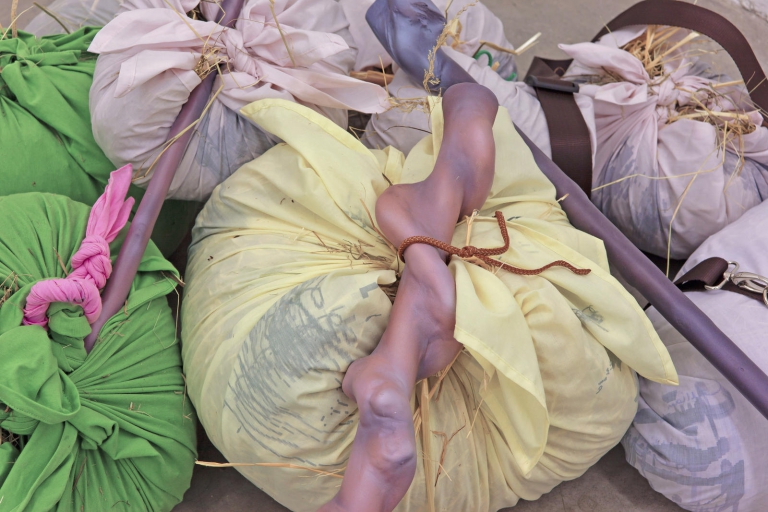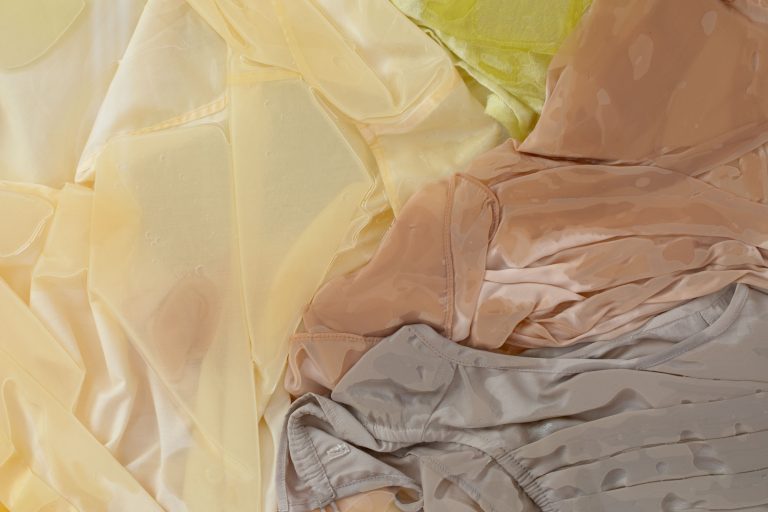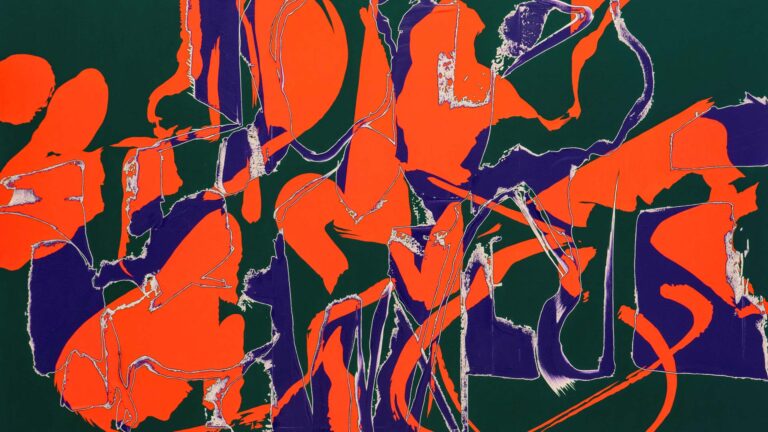Artist: Jorge Galindo
Exhibition title: Fata Morgana
Venue: L21 Gallery, Mallorca, Spain
Date: May 14 – June 23, 2021
Photography: Lúa Oliver / all images copyright and courtesy of the artist and L21 Gallery, Mallorca
THE SAFFRON ROSE
A Galician sailor reports a strange apparition occurring while sailing in a vessel across the North Sea: the Shetland Islands appear to be floating in the air. The “fata morgana” occurs when there is an alteration in the temperature over the sea, which inverts the usual perception of the landscape, causing us to see mirages. Our visual system has its glitches and also its limitations in terms of being able to discern and make sense of tiny perceptions, such as the changing position of the petals of a flower. How can their movements be captured?
Painting is the malleable medium par excellence that allows us to explore the ambiguity of images and their relationship with our identity. Flowers have been a constant trope in art and culture since before they became the obsession of 17th Century Dutch painters or impressionists. Thinking through flowers brings us back to concepts such as beauty, desire or mourning, while at the same time establishing a dialogue with our habitat.
To speak about the abstraction of forms in Jorge Galindo’s canvases would mean reducing his language to design, line or colour. However, by emphasising process, there is room for joy, for a figure, for pictorial space. Movements, not states. A potential growth and not a finality. “Fata Morgana” presents works from two different series, made in different periods of time, but both based on images of flowers on postcards from the end of the century, altered with colours that accentuate the folds, lines and tones of what they represent. It is also significant to mention the origin of the paper on which the “Braille Flowers” are executed, as it comes from small notebooks that an ONCE1 venue in Madrid discarded in the rubbish in the 1980s, which Galindo collected and transformed, at that time, into his first treatises on how to paint. Sketches, outlines and colour charts now transformed into dancing flowers. The material is a nod towards to the subtle language of Braille and draws a parallel with that of painting, a return to the “language before language”, in the artist’s words.
Romance of the yellow Indian.
The dragging of scares.
If these paintings were songs they would be part of the lyrical tradition of zarzuela, perhaps included in “The Saffron Rose” (premiered in 1930 at the Teatro Calderón in Madrid), a work which in two acts deals with one of the classic themes of this genre: love between two characters from different social classes. Saffron, something as fragile as love, which serves to spice and dye yellow and which projects us once again towards desire. A quick search on the internet tells me that only three stigmas grow on each saffron flower and that the method of cultivation and harvesting has evolved very little, requiring abundant manpower to carry out the various stages of processing. The most precious gesture (as in painting) is manual.
I start working on this garden-text wondering about the reason for the colours in flowers, which turns out to be the same reason why a person can be born with brown or blond hair, or have blue or green eyes. Both plants and humans develop colour in their organisms in order to reproduce. From a biochemical point of view, different pigments generate different colours, just like in a carrot or a tomato. It is a matter of genes and sexual needs, because if a plant needs to attract birds or insects it will develop very bright colours. But not only do they attract, their colours also provoke our passions. For, as Jean-Luc Nancy says, “nothing is more singular than the sensual, erotic and affective discharge that certain bodies produce in us”2 – Bodies that may include that of a painting.
What is clear is that when language is not enough, the best thing to do is to say it with flowers.
- National Organization of Spanish blind people.
- Jean-Luc Nancy: Corpus, 2020. Quoted by Heather Philipson in “Dears Issue 2”, 2021.
-Cristina Ramos
Jorge Galindo (Madrid, 1965) trained in the workshops of the Círculo de Bellas Artes in Madrid, his artistic oeuvre spans more than three decades. Describing his own work as “dirty pop”, his paintings are gestural and expressionistic, often using elements of collage and frequently painted with such energy that they verge on abstraction. Most of his canvases are monumental in scale and his work has been exhibited extensively, including the Hall Art Foundation (Schloss Derneburg), Hamburger Bahnhof, Berlin; Hirshhorn Museum, Washington; Museo Nacional Centro de Arte Reina Sofía, Madrid; the Hammer Museum of Art, Los Angeles; Centro Andaluz de la Fotografía, Almería (with film director Pedro Almodóvar), Museo Lázaro Galdiano, Madrid and MAXXI, Rome.
His work can be found in major national public collections such as CA2M (Centro de Arte Dos de Mayo), Móstoles; MUSAC (Museo de Arte Contemporáneo de Castilla y León), León; Helga de Alvear Collection, Madrid/Cáceres; Fundación La Caixa, Barcelona; IVAM (Instituto Valenciano de Arte Moderno, Valencia); Fundación Caja Madrid, Madrid and Patio Herreriano Museo de Arte Contemporáneo Español, Valladolid, amongst many others.
Jorge Galindo, Fata Morgana, 2021, exhibition view, L21 Gallery, Mallorca
Jorge Galindo, Cesta con flores, 2020, Oil on canvas, 250 x 300 cm
Jorge Galindo, Fata Morgana, 2021, exhibition view, L21 Gallery, Mallorca
Jorge Galindo, Flores Braille 3, 2020, Oil on braille paper glued to canvas, 100 x 81 cm
Jorge Galindo, Fata Morgana, 2021, exhibition view, L21 Gallery, Mallorca
Jorge Galindo, El arrastre de los sustos, 2020, Oil on canvas, 300 x 400 cm
Jorge Galindo, Fata Morgana, 2021, exhibition view, L21 Gallery, Mallorca
Jorge Galindo, Romanza del amarillo indio, 2020, Oil on canvas, 240 x 200 cm
Jorge Galindo, Flores Braille 1, 2020, Oil on braille paper glued to canvas, 100 x 81 cm















